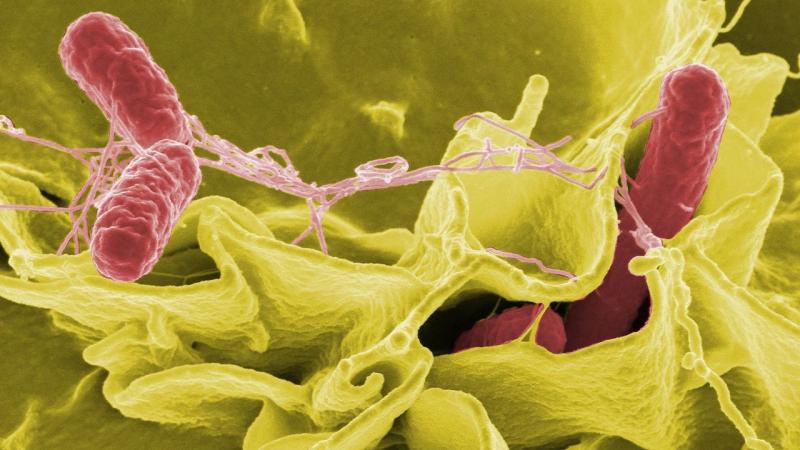
Typhoid and paratyphoid fevers are life-threatening infections characterised by high fever, diarrhoea and vomiting. They are one of the most common diseases caused by water or food contaminated with the bacteria Salmonella typhi and Salmonella paratyphi. In India, about 494 children per 100,000, in the age group of 5-15 years, suffer from typhoid. The disease places a significant burden among young children.
In a recent review study, researchers from Christian Medical College (CMC), Vellore, All India Institute of Medical Sciences (AIIMS), New Delhi, TN Medical College & B Y L Nair (BYLN) Hospital, Mumbai, and Translational Health Sciences Technology Institute (THSTI), Faridabad, throw some insights into the recent trend of the disease. The study was published in The American Journal of Tropical Medicine and Hygiene and was supported by the Bill & Melinda Gates Foundation.
The researchers analysed the number of diagnosed cases of typhoid in hospitals at CMC, AIIMS, and BYLN for over 15 years (2000-2015). They also reviewed data during the same period on access to potable water, hygiene and sanitation, population density, and economic growth from nationally representative demographic health surveys and also data on antimicrobial use and antimicrobial resistance. They monitored water supply and sanitation reports by the United Nations Children’s Fund (UNICEF), the World Bank, and the Joint Monitoring Program.
The study found a decline in the cases of typhoid during the 15-year period.
“There appears to be a decline in the isolation of S. typhi in blood cultures, which is more apparent in the past 5 years, which can be temporally related to economic improvement, female literacy, and the use of antibiotics such as cephalosporins and azithromycin”, say the researchers.
The researchers observed that the three hospitals had similar numbers of S. typhi diagnosis. The percentage of definite S. typhi diagnosis declined from 0.62% in 2000 to 0.18% in 2015 at AIIMS, from 1.38% in 2000 to 0.17% in 2015 at CMC, and from 0.4% in 2010 to 0.2% in 2015 at BYLN, “This declining pattern may be confounded by several factors, including prior antimicrobial therapy, differing health seeking practices, changed diagnosis guidelines, and laboratory methods”, added the researchers.
The researchers then sought to find out if improved sanitation and access to clean water contributed to the reduction in typhoid cases. They found that sanitation improved from 49.3% in 1990 to 62.6% in 2015 in urban areas, and from 5.6% to 28.5 % during the same period in rural areas. There was also an increase in access to clean water. In 1990, 47% of the population in urban areas and only 6% in rural areas had access to clean drinking water. However, in 2015, this had risen to 54% and 16% respectively.
The number of people defecating in the open had also reduced from 653 million in 1990 to an estimated 569 million in 2015. With improved urban planning, the fraction of people living in the slums had decreased from 54.9% in 1990 to 24% in 2015. Besides, female literacy rate had almost doubled from a mere 33.7% in 1991 to 63.0% in 2015.
“Our review of the trends suggests that although commendable, the progress in access to safe water and sanitation is neither qualitatively nor quantitatively sufficient to explain the decline in typhoid across different settings in India. Therefore, other interventions such as hygiene education and regulating commercial food handling should be implemented to create an environment that provides an effective barrier to S. typhi infection,” remark the authors.
Would antibiotics not work, you ask? Well, in today’s world of antibiotic-resistant bacteria, S. typhi and S. paratyphi have been found to be susceptible to only three antibiotics—ampicillin, co-trimoxazole, and chloramphenicol; although the number of resistant strains is evolving. The bacteria have already become resistant to commonly used antibiotics like nalidixic acid. “In future, the rampant, early, and indiscriminate use of antibiotics causing the emergence of drug-resistant strains may unmask clinical infection, resulting in a resurgence of disease at different locations in India making it a matter of great concern”, warn the researchers.
Although the study cannot establish a causal relationship between the decline in typhoid cases and the improvements in contextual factors, the researchers speculate that this declining trend may be a result of increasing per capita income, improved access to health care and early antibiotics.
“Increasing antibiotic resistance may result in a resurgence of disease unless effective public health interventions are rapidly and appropriately deployed,” concluded the authors, stressing the need for urgently improving drinking water and sanitation facilities in the country before there is a severe outbreak of enteric fever.






